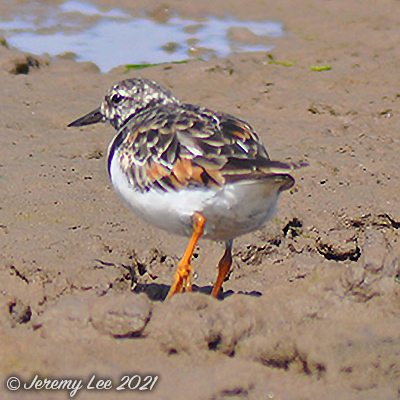
 |
|
Scientific Classifications explained » Amphibians » Ants » Aphids » Bees » Beetles » Birds » Bugs » Butterflies » Caterpillars » Damselflies » Dragonflies » Earwigs » Flies » Frog/Leafhoppers » Fungi » Galls » Grasshoppers » Harvestmen » Hoverflies » Lacewings » Ladybirds » Leaf Mines » Lichens » Mammals » Millipedes » Mosses » Moths » Sawflies » Slugs » Snails » Spiders » Trees & Shrubs » Wasps » Wild Flowers » Woodlice » Postboxes |
UK Nature > Birds > Arenaria interpres

Scientific Name: Arenaria interpres Common Name: Turnstone Arenaria interpres, more commonly known as the Turnstone, is smaller than a redshank, has a mottled appearance with brown or chestnut and black upperparts and brown and white or black and white head pattern, whilst their underparts are white and legs orange. They spend most of their time creeping and fluttering over rocks, picking out food from under stones. They like rocky shores as well as sandy and muddy ones, and particularly likes feeding on rocks covered with seaweed. They will feed along seawalls and jetties, eating insects, crustaceans and molluscs. It is present in the UK for most of the year and found all around the coastline. Birds from Northern Europe pass through in July and August and again in spring. Canadian and Greenland birds arrive in August and September and remain until April and May. Non-breeding birds may stay through the summer. |
|

https://www.uknature.co.uk is a website dedicated to showing the immense diversity of UK nature and wildlife. Our vast range of habitats, from lowland arable to snow covered mountains, from storm-ravaged coastlines to peaceful inland freshwater lakes and rivers, from dry, sandy heaths to deciduous and coniferous forests, all these habitats contribute to the abundance of UK nature. We have wild birds in huge numbers either residing or visiting our shores (597 recorded species as at July 2013) and we must also not forget the humble back garden with its grass lawns, flower beds filled with nectar rich flowers, shrubs and trees, all designed to attract huge numbers of insects such as bees, moths, butterflies and hoverflies; and finally the small ponds which provide safe havens for frogs, toads, newts and even slow worms and grass snakes. www.uknature.co.uk is the showcase for my personal passion, photographing uknature in all its glory. I sincerely hope you all enjoy the fruits of my labours. This site and all images contained therein is © Jeremy Lee 2004 - 2025. All Rights Reserved. Site design by Jeremy Lee. Site development & IT Support by Stuart Lee. |